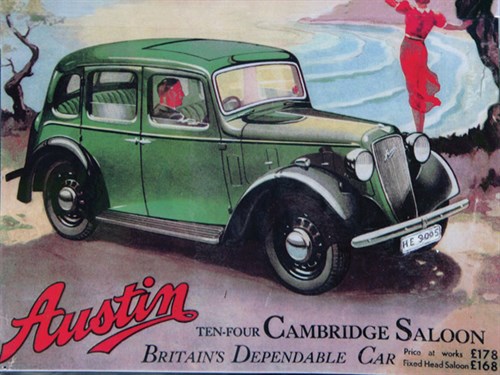Austin’s early post-war cars once seemed to be everywhere, but you’ll have to look long and hard if you want one now...

The 1945-1947 Austin Ten-Four was a revived pre-war design that lasted only until Longbridge had the replacement A40 Somerset ready. Introduced in 1939, its semi-integral construction was a step forward, but its side-valve engine dated back to 1932. The attractive saloon body was designed by Dick Burzi and during the war, the armed services took saloon, van and pick-up ("Tilly", or utility) models. The Ten-Four was a strong seller, too: 55,521 were built.
VITAL STATISTICS
Engine 1125cc/4-cyl/side-valve
Power (bhp@rpm) 32bhp@4000rpm
Torque (lb ft@rpm) Not quoted
Top speed 62mph
0-60mph 40 sec+
Consumption 35mpg
Gearbox 4-speed manual
WHAT TO LOOK FOR
BODYWORK & CHASSIS
In most respects, this will be your primary concern on one of these Austins. Parts are simply not available off the shelf, and you’ll be very lucky to find a scrapper that has any useable body parts on it. Most cars that have got to the scrap stage are likely to be in a state of near-collapse.
Watch out for problems with the sliding sunroof. It can leak, and owners on a budget tend to seal the roof up without attempting a proper repair. Collapse most often results from rot in the body pillars, which will give way eventually under the weight of the doors – especially if a car has been in long-term storage with the doors left open.
Look for rot around the edges of all panels, including the boot, doors, bonnet and wings. Some body sections are shared with the 8hp, 12hp and 16hp models, but remember that the larger-capacity cars also have some larger body dimensions.
ENGINE

The side-valve engine is as simple as they come, and shares the basics of its design with pre-war Austin Tens. Engine spares are therefore less of a problem than spares for other areas of the car. Even so, you’d be wise to develop strong links with specialist suppliers and fellow owners, and to keep a close and regular eye on what’s available on the web. Items do turn up out of nowhere, but then it’s a case of first come, first served. Bear in mind that the related wartime "Tilly" engine was an 11hp unit with a larger bore, so don’t be misled into buying the wrong parts for your engine!

RUNNING GEAR
The mechanical components are tough and simple. The four-speed gearbox has no synchromesh on bottom gear and doesn’t like to be rushed, and the brakes are Girling mechanical items which gave adequate stopping power for the mid-1940s. Springs are semi-elliptics all round.
The chassis sidemembers are welded to that floorpan to create a platform-like structure which is torsionally quite stiff. But do check for problems in the floorpan. Once it’s been weakened by rust, the ‘chassis’ can start to twist and if the body pillars have been weakened, then the whole body structure is in danger of collapse.
INTERIOR
The Ten-Four’s interior reflected Britain’s love of understatement at the time. There’s not a lot to the dashboard, but everything is well-made and placed just so. The seats were upholstered in leather (yes, even at this budget level), so bear this in mind when assessing a car with a tatty interior, since they will be expensive to re-cover.
If there are problems with the instruments or switches, specialists can usually help, but don’t expect to find any seats or trim panels for sale. These are items that you’ll have to get made specially. If you’re not sure what interior items should look like, look at some good original-condition cars, take plenty of photographs, and
then show your trimmer what you’re looking for.

OUR VERDICT
You’ll buy an Austin Ten-Four of this vintage mainly for nostalgic reasons. The cars didn’t represent any great leap forward in engineering or styling terms, and were always intended as Austin’s bread-and-butter product. However, they have always been rather attractive cars that recall a lost age of motoring, and they will always attract interest at shows and events. These cars are enjoyable, family-friendly classics, but you’ll need to accept that hunting for spare parts will likely be a permanent occupation, so make sure you have somewhere in your garage or loft to keep them all!